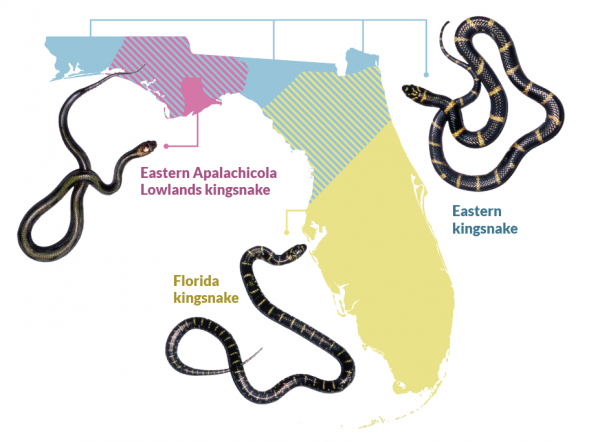Florida Museum of Natural History scientists have reclassified three types of kingsnakes found in the state, elevating them to species status.
Fossil records and DNA analyses show the Florida kingsnake, eastern kingsnake and Eastern Apalachicola Lowlands kingsnake have unique genetic lineages likely developed because of ancient geographical barriers.
“People used to see kingsnakes more frequently before the 1980s, but nearly all field biologists today have never seen one in the wild,” said Krysko, lead author of the study, published the Journal of Heredity.
Historically, researchers often classified snake species by color and markings, but modern genetic analysis technology has allowed scientists to reexamine and refine snake classification, said Leroy Nunez, a study co-author and graduate student at the University of Florida’s School of Natural Resources and Environment.

Florida Museum graphic by James Young and Kenneth Krysko
Reclassifications for other kingsnakes across the country may follow the elevation of these three Florida snakes to species status, Nunez said.
“We focused mainly on populations on the eastern side of the Appalachian Mountains, but there are many different populations westward to the Pacific coast,” he said. “We hope to study those populations as well with many more samples.”
The scientists sequenced DNA from blood, bone, muscle tissue and shed skins from 66 live specimens and salvaged snakes found dead on the road.
They also reviewed museum specimens to uncover historical population trends where these species lived over the past 500,000 years. Studying the snakes’ biological ancestors revealed the three species diverged during the Pleistocene Epoch about 540,000 years ago.
Nunez said the divergences likely occurred because of geographic barriers, such as rivers, that enabled the evolution of genetically distinct populations.
Currently, the Florida kingsnake, Lampropeltis floridana, is found only on the Florida Peninsula while the Eastern Apalachicola Lowlands kingsnake, L. meansi, lives in the Panhandle. The Eastern kingsnake, L. getula, is found in the northern peninsula, the Panhandle and northward along the Atlantic coast to southern New Jersey.
Harmless to humans, kingsnakes are predators that help maintain ecosystem balance by feeding on turtle eggs, other snakes, rodents, birds, lizards and frogs.
“They are important for biodiversity, especially in Florida, where a lot of species have been introduced over the last few decades that are changing the landscape of our ecosystems,” Nunez said.
He said Florida residents can help conserve kingsnakes by preserving natural habitats and refraining from killing or harming native snakes. The Florida Museum’s snake identification website offers a guide to the state’s species.
“We hope people use this information as support for conservation, to show the importance of natural biodiversity in southeastern North America and how rich an area Florida is,” Nunez said.
Learn more about the Herpetology Collection at the Florida Museum.